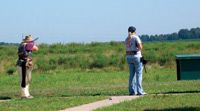Aiming for perfection
Here's the story of a successful optometrist who is equally talented at trapshooting.

Dr. Winkel, who practices at Twin Rivers Optical and Eyecare here, inherited her love of the sport from her father, who coached her on gun safety and trapshooting beginning when she was 10 years old.
"We always did things as a family," she said. "One day my father, who was a shooter, decided to teach me how to shoot because I was bored."
Now 47, she has competed in hundreds of shooting events across the country, winning many awards.
Into the air
In trapshooting, shooters stand anywhere from 16 to 27 yards behind a trap house, the spot on a field from which a machine throws disks or clay birds into the air. The objects travel about 47 miles per hour at a variety of angles for about 50 yards before they hit the ground. Each field has five shooting stations from which shooters try to hit the birds. At most events, competitors shoot at 100 to 200 targets.
Dr. Winkel competes in three types of trapshooting events:
The Northwest trapshooting season runs from March through September, but she begins practicing at a local gun club in January. Although Dr. Winkel doesn't necessarily enjoy being outdoors in the wind, rain, snow, or frigid temperatures, she still practices so she can be prepared for any weather condition during competitions.